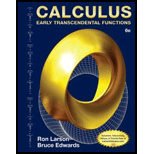
Concept explainers
Writing
(a)
To calculate: Acomponent form of u and v where
Answer to Problem 1RE
Solution:
Component form of uand v is
Explanation of Solution
Given:
Formula used:
If
Calculation:
If u
and
The component form of u is
If v
and
The component form of v is
(b)
To calculate: u and vas the linear combination of the standard unit vectors i and jwhere
Answer to Problem 1RE
Solution:
The vectors
Explanation of Solution
Given:
Formula used:
If
Calculation:
According to the calculation of part (a), a component form of u and vis
Therefore, the vectors
(c)
To calculate: Magnitudes of u and vwhere
Answer to Problem 1RE
Solution:
The magnitude of u is
Explanation of Solution
Given:
Formula used:
According to the Distance Formula, the length (or magnitude) of vectoru is:
Calculation:
As per part (a),
and v=
Therefore, the magnitude of u is
(d)
To calculate: The value of
Answer to Problem 1RE
Solution:
The value of
Explanation of Solution
Given:
Formula used:
The scalar multiple of c and u is the vector:
The vector sum of u and v is the vector:
Calculation:
According to the calculation of part (a), a component form of u and v is
Find the value of
Want to see more full solutions like this?
Chapter 11 Solutions
Bundle: Calculus: Early Transcendental Functions, Loose-leaf Version, 6th + WebAssign Printed Access Card for Larson/Edwards' Calculus: Early Transcendental Functions, 6th Edition, Multi-Term
- Explain the relationship between 12.3.6, (case A of 12.3.6) and 12.3.7arrow_forwardExplain the key points and reasons for the establishment of 12.3.2(integral Test)arrow_forwardUse 12.4.2 to determine whether the infinite series on the right side of equation 12.6.5, 12.6.6 and 12.6.7 converges for every real number x.arrow_forward
- use Corollary 12.6.2 and 12.6.3 to derive 12.6.4,12.6.5, 12.6.6 and 12.6.7arrow_forwardExplain the focus and reasons for establishment of 12.5.1(lim(n->infinite) and sigma of k=0 to n)arrow_forwardExplain the focus and reasons for establishment of 12.5.3 about alternating series. and explain the reason why (sigma k=1 to infinite)(-1)k+1/k = 1/1 - 1/2 + 1/3 - 1/4 + .... converges.arrow_forward
- Explain the key points and reasons for the establishment of 12.3.2(integral Test)arrow_forwardUse identity (1+x+x2+...+xn)*(1-x)=1-xn+1 to derive the result of 12.2.2. Please notice that identity doesn't work when x=1.arrow_forwardExplain the key points and reasons for the establishment of 11.3.2(integral Test)arrow_forward
- Algebra & Trigonometry with Analytic GeometryAlgebraISBN:9781133382119Author:SwokowskiPublisher:Cengage
 Trigonometry (MindTap Course List)TrigonometryISBN:9781337278461Author:Ron LarsonPublisher:Cengage Learning
Trigonometry (MindTap Course List)TrigonometryISBN:9781337278461Author:Ron LarsonPublisher:Cengage Learning Algebra and Trigonometry (MindTap Course List)AlgebraISBN:9781305071742Author:James Stewart, Lothar Redlin, Saleem WatsonPublisher:Cengage Learning
Algebra and Trigonometry (MindTap Course List)AlgebraISBN:9781305071742Author:James Stewart, Lothar Redlin, Saleem WatsonPublisher:Cengage Learning  Trigonometry (MindTap Course List)TrigonometryISBN:9781305652224Author:Charles P. McKeague, Mark D. TurnerPublisher:Cengage Learning
Trigonometry (MindTap Course List)TrigonometryISBN:9781305652224Author:Charles P. McKeague, Mark D. TurnerPublisher:Cengage Learning Elementary Linear Algebra (MindTap Course List)AlgebraISBN:9781305658004Author:Ron LarsonPublisher:Cengage Learning
Elementary Linear Algebra (MindTap Course List)AlgebraISBN:9781305658004Author:Ron LarsonPublisher:Cengage Learning




